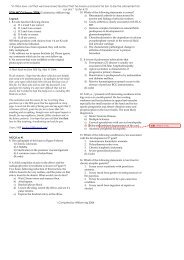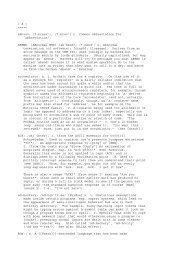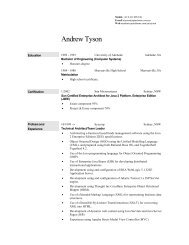Notes to Submission to the Productivity Commission Inquiry into the ...
Notes to Submission to the Productivity Commission Inquiry into the ...
Notes to Submission to the Productivity Commission Inquiry into the ...
You also want an ePaper? Increase the reach of your titles
YUMPU automatically turns print PDFs into web optimized ePapers that Google loves.
Externalities/Public Goods: Inadequate Supply of Design FeaturesDesign features that ignore <strong>the</strong> needs of people with impairments mean that considerabletime is wasted overcoming design obstacles. When a person spends time looking for anentrance, or using an indirect path of travel, or negotiating <strong>the</strong> quality of a service, <strong>the</strong>ywould presumably prefer spending <strong>the</strong>ir time in some leisure activity or in employment.In <strong>the</strong> extreme, design features that ignore <strong>the</strong> needs of people with impairments maymean non-participation in <strong>the</strong> workforce. For when a person misses a job interviewbecause <strong>the</strong>ir assistant or taxi is late or because an advertisement is not advertised inaccessible format or because <strong>the</strong> employment criteria have ignored disability issues, <strong>the</strong>probability of finding a job is reduced.Design features may be physical or administrative. Examples of inaccessible physicaldesign features are obvious enough and relate particularly <strong>to</strong> people with visibledisabilities e.g. lack of an access ramp, non-Braille but<strong>to</strong>ns, lack of a hearing loop in apublic address system etc. Inaccessible administrative design is less obvious, but it can beas disabling as inaccessible physical design. Administrative design features can relate <strong>to</strong>methods (e.g. allocating queues in<strong>to</strong> a cinema with a limited number of well-locatedaccessible seats on a ‘first-come first-served’ basis) or rules (e.g. inflexible schedules androsters that do not account for disability episodes).Cost minimising firms and organisations will only incorporate accessibility designfeatures in<strong>to</strong> <strong>the</strong>ir goods and services if <strong>the</strong>y believe <strong>the</strong> cost of <strong>the</strong> specific additionaldesign is less than <strong>the</strong> expected revenue <strong>the</strong>y derive from <strong>the</strong> design. This is consistentwith a socially efficient outcome only if <strong>the</strong> design feature produces no external effects.Where <strong>the</strong> lack of a design feature leads <strong>to</strong> a loss of valuable time by a person with adisability or an assistant, <strong>the</strong>re is an external effect which in general <strong>the</strong> supplier of <strong>the</strong>design feature does not take in<strong>to</strong> account when deciding whe<strong>the</strong>r or not <strong>to</strong> incorporate <strong>the</strong>design feature in<strong>to</strong> <strong>the</strong>ir product. Thus for example, a cinema proprie<strong>to</strong>r will ensureaccess in<strong>to</strong> <strong>the</strong> cinema only if <strong>the</strong>y expect that <strong>the</strong> expected capitalised profit <strong>to</strong> be madefrom wheelchair users is likely <strong>to</strong> be greater than <strong>the</strong> cost of ensuring access. The timesaved in not having <strong>to</strong> go <strong>to</strong> a less preferred cinema location, or in not having <strong>to</strong> have anassistant pull <strong>the</strong> wheelchair up <strong>the</strong> stairs is ignored by <strong>the</strong> cinema proprie<strong>to</strong>r even though<strong>the</strong> time saved by <strong>the</strong> ramp are social benefits.There are three types of externalities relevant <strong>to</strong> people with disabilities and <strong>the</strong> DDA:• ‘direct externalities’ affect people with disabilities;• ‘network externalities’ are due <strong>to</strong> <strong>the</strong> interdependence of demand for varioustypes of goods and services of interest <strong>to</strong> people with disabilities.• ‘associate externalities’ affect <strong>the</strong> associates of people with disabilities; andThese three types of externalities can be illustrated by considering an access ramp forwheelchair users and a wheelchair-accessible transport system:• without a ramp, a wheelchair user might not be able <strong>to</strong> attend an interview for ajob or might have <strong>to</strong> spend time overcoming an obstacle (direct externality);17
















